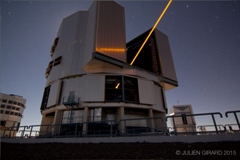
Laser guide star installed on Very Large Telescope
source:electrooptics.com
keywords: laser system Laser Guide
Time:2015-06-11
A laser system has been installed on the European Southern Observatory’s Very Large Telescope (VLT) at the Paranal Observatory, Chile. It is the first laser to be fitted as part of the 4 Laser Guide Star Facility (4LGSF), which will allow the VLT to obtain diffraction-limited images of a greater number of stars in the galaxy.
The SodiumStar system is a high-power ‘guide star’ laser designed for adaptive optics control in ground-based telescopes.


Adaptive optics is employed in modern telescopes in order to correct the wavefront distortion induced by the Earth’s atmosphere, which causes blurred images. Laser guide stars, which excite sodium atoms in the upper atmosphere, can be used as a reference object for adaptive optics.
Laser company, Toptica, will supply its SodiumStar laser as a guide star in order to excite sodium atoms in the mesosphere located 90-110km above the Earth’s surface. The re-emitted fluorescence light of the atoms undergoes the same distortions in the atmosphere as the light emitted from real stars further out in the universe. Therefore, the fluorescence light of the sodium atoms can be used to measure and compensate for the distortions with the adaptive optics of the telescope. In this way, diffraction-limited images of real stars can be obtained with the ground-based telescope.
The core of the installed SodiumStar laser system is based on a narrow-band seed diode laser, a fibre-based Raman fibre amplifier module and a high-efficient resonant frequency conversion unit.
Raman fibre amplification is a nonlinear interaction between a seed laser and a spectrally shifted broadband pump laser within an optical fibre. The amplifier is fed with the light of a DL DFB infrared diode laser and the output is frequency-doubled to achieve a total average output power of more than 20W at a wavelength of 589nm. The laser light has a linewidth of less than 5MHz and a 10 per cent re-pumper frequency sideband at 1.7GHz.
A team of Toptica and ESO engineers were able to successfully complete the foreseen set of verification tests, preceding the first light and several on-sky measurements. This is a major step towards the completion of the full Adaptive Optics Facility. The installation of the three additional SodiumStar lasers is planned to complete the 4LGSF in the near future.
MOST READ
- RoboSense is to Produce the First Chinese Multi-beam LiDAR
- China is to Accelerate the Development of Laser Hardening Application
- Han’s Laser Buys Canadian Fiber Specialist CorActive
- SPI Lasers continues it expansion in China, appointing a dedicated Sales Director
- Laser Coating Removal Robot for Aircraft
PRODUCTS
 FISBA exhibits Customized Solutions for Minimally Invasive Medical Endoscopic Devices at COMPAMED in
FISBA exhibits Customized Solutions for Minimally Invasive Medical Endoscopic Devices at COMPAMED in New Active Alignment System for the Coupling of Photonic Structures to Fiber Arrays
New Active Alignment System for the Coupling of Photonic Structures to Fiber Arrays A new industrial compression module by Amplitude
A new industrial compression module by Amplitude Menhir Photonics Introduces the MENHIR-1550 The Industry's First Turnkey Femtosecond Laser of
Menhir Photonics Introduces the MENHIR-1550 The Industry's First Turnkey Femtosecond Laser of Shenzhen DNE Laser introduced new generation D-FAST cutting machine (12000 W)
more>>
Shenzhen DNE Laser introduced new generation D-FAST cutting machine (12000 W)
more>>
